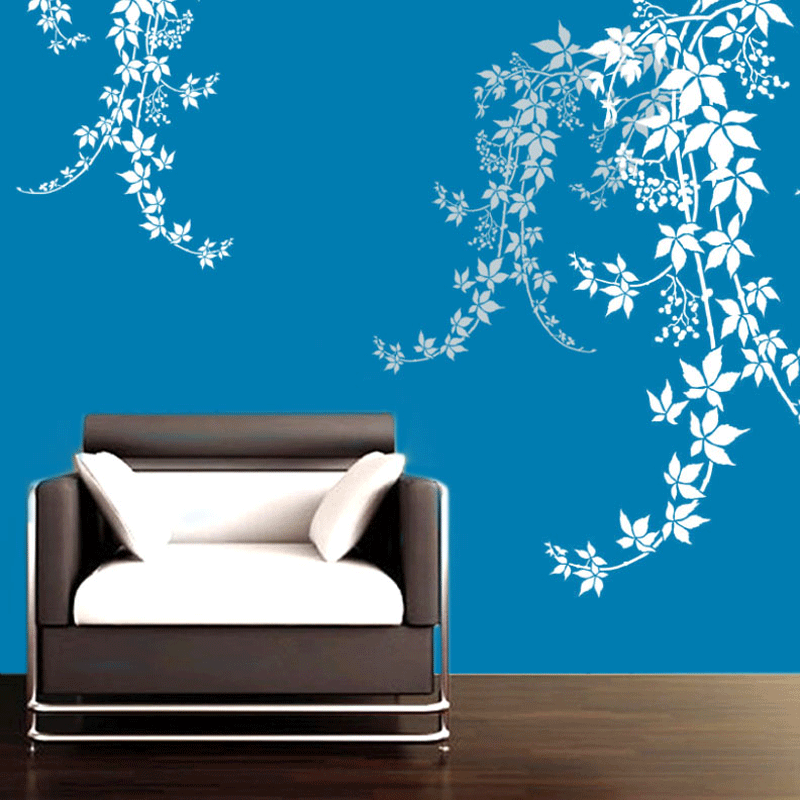
OR

So you want to make stencils? That’s not surprising considering how stencils are becoming popular as a quick way to decorate a bare wall at homes and offices. For a long time, stencils have been one of the most popular techniques of urban artists worldwide. Artists love stencils because they are fast and easy to use, but the process of creating a stencil is neither quick nor simple. There are several things you need to consider before getting into the process.
Here, Bibek Thapa Magar, graphic designer at ArtLab Nepal, talks about the nitty-gritties of stencils, and interior designer Lasata Shrestha explains how we can incorporate this contemporary form of art into our home décor.
About stencils
“Stencil, in the visual arts, is a technique to create an art form,” says Bibek. It uses a thin sheet of material, usually paper or cardboard, and often metal too, that is cut into different shapes or letters to produce the desired design on a surface to be decorated by passing pigment through the cut-out holes on the material.
Things to keep in mind
Bibek says, “You need to have proper tools like cutter and paper for stencil art. You need to be able to differentiate the positive (the part you want to paint) and the negative part (the part that gives the shape to the art and won’t be painted), during the process of painting.” You also need to be able to determine the size and the number of colors in your stencil artwork before you begin.
Types of stencils
Stencils can be divided according to layers. “A multi-layer stencil has multiple layers of papers and is used to paint different colors, while a single-layer stencil uses a single sheet of paper which is only used to paint a specific color,” explains Bibek. The size of your stencil will determine the details of the pattern. You have to keep in mind that the design isn’t too cluttered. The colors, on the other hand, determine how many layers or boards you are going to need. And these are just the very basic things. To create a good stencil, you will need to draw, retouch an image, and choose the right materials among other important things.
How to use stencils
First, according to the design or art you want to draw on your wall, you will need to print the pattern. After that, it is necessary to recognize which part of the design you would want to paint. Using a cutter, you will need to slowly cut out the shape you are looking for and press that against the wall firmly. After this, simply apply the paint on top of it. Make sure the paint doesn’t run though otherwise you might have to repaint the whole wall and redo it all again.
Stencils for home décor
Interior designer, Lasata warns that you will need to be sure about the design you want on your wall because once painted it is difficult to change the design or modify it much. You will also need to make sure that there are no patches or mistakes while imprinting the design on the wall. Then, you will need to determine the color and layer of the stencil.
“While choosing the color for the design, you should also be mindful about the existing color of the wall,” she says. If the wall is painted a light color, she says, it will be better to use darker shades while drawing the design, but if you have a darker color wall, go for light colors.
The ideal place for stencils
“Instead of using stencil art on every wall of the room, use it on a wall that gets more light and is more visible. It is also important to make sure the wall has no windows or doors or there isn’t a couch or dressing table covering a major portion of the wall your want to paint on,” explains Lasata.
Suitable designs
“Stencil art design can’t be specified according to the size of the room, but you will need to be mindful about who uses that room the most,” says Lasata. According to Lasata, if you are thinking of using stencils in a children’s room, it would be better to use shapes or designs of cartoon characters or animals. If you are thinking about using the designs in your living room, geometric shapes, floral and nature designs might be ideal for that space.
The final touch
After putting all that effort into making a stencil, you want it to be done nicely. So make sure the wall you are making stencils on has a smooth finish. “Use wall putty over your walls before applying stencils,” says Lasata, adding that this will give rough walls a smooth finish. “If you want to go for more of an industrial décor, you can even use stencils over a brick wall,” says the interior designer. And patience is of paramount importance in doing a proper stencil art. You have to be slow and steady, and ready to wait. Tip: Use a hairdryer to speed the paint drying time.


You May Like This

Alfesco Open Art Exhibition begins at Nepal Art Council
KATHMANDU, Feb 14: Alfresco Media and Event organized ‘Alfresco Open Art Exhibition and Competition 2017’ for pre-primary level to college level... Read More...

Seventh National Fine Art Exhibition: Widening scope of arts
The Seventh National Fine Art Exhibition organized by Nepal Academy of Fine Arts has been shown from June 19 –... Read More...

A German artist turns Kathmandu’s trash into art
KATHMANDU, Sept 7: One man’s trash is another man’s treasure. For German artist Lena Koester, Kathmandu’s everyday trash is her inspiration... Read More...




Just In
- Kushal Dixit selected for London Marathon
- Nepal faces Hong Kong today for ACC Emerging Teams Asia Cup
- 286 new industries registered in Nepal in first nine months of current FY, attracting Rs 165 billion investment
- UML's National Convention Representatives Council meeting today
- Gandaki Province CM assigns ministerial portfolios to Hari Bahadur Chuman and Deepak Manange
- 352 climbers obtain permits to ascend Mount Everest this season
- 16 candidates shortlisted for CEO position at Nepal Tourism Board
- WB to take financial management lead for proposed Upper Arun Project






_20220508065243.jpg)








Leave A Comment